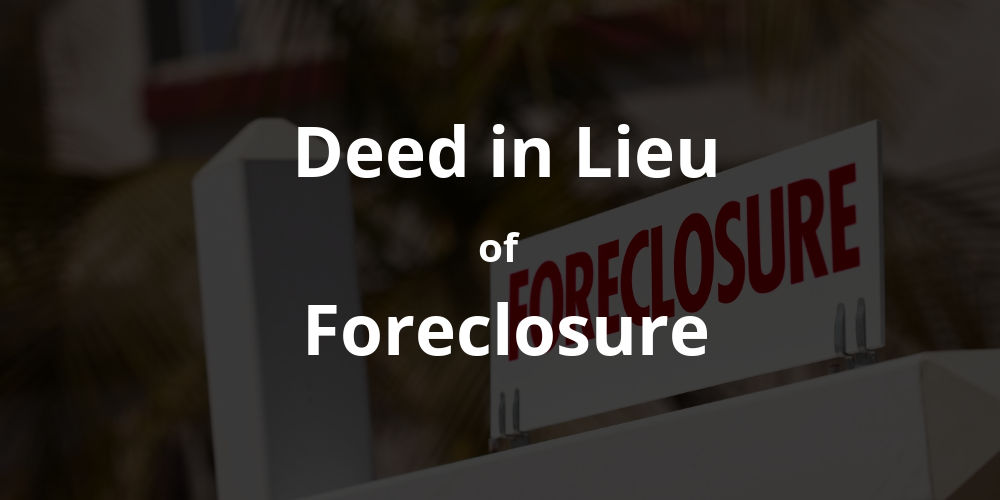Find foreclosed homes for sale up to 60% below market value on our foreclosure listings
Find foreclosed homes for sale up to 60% below market value on our foreclosure listings
When you hear the phrase “deed in lieu of foreclosure” what comes to mind?

Also known as a mortgage release, there are many moving parts associated with this transaction.
Generally speaking, this is a strategy used by a borrower in an attempt to avoid foreclosure. With this approach, the borrower deeds the home back to the lender in exchange for the release of any and all obligations associated with the mortgage.
Note: in order for a deed in lieu of foreclosure to work, both sides must agree to the terms and conditions.
If you are interested in a deed in lieu of foreclosure, it’s important to take a few simple steps:
There is a lot that you need to know about a deed in lieu of foreclosure, but here’s the most important point: there are benefits to both the borrower and the lender. For this reason, it’s easier for both parties to work out the details and reach a final agreement.
From the standpoint of the borrower, there are several benefits of a deed in lieu of foreclosure:
These are not the only benefits associated with a deed in lieu of foreclosure, but they are among the most important. With these guiding you, it’s much easier to decide if this strategy will suit you from a personal and financial point of view.
By now, you should have a clear idea of how a deed in lieu of foreclosure works and the benefits that it has to offer. However, you don’t want to move forward until you first understand your other options.
Many people find themselves comparing a deed in lieu of foreclosure and a short sale. While some believe that these are one in the same, there are some key differences to become aware of.
First things first, you need to understand the definition of a short sale:
“A short sale is a sale of real estate in which the net proceeds from selling the property will fall short of the debts secured by liens against the property. In this case, if all lien holders agree to accept less than the amount owed on the debt, a sale of the property can be accomplished.”
With that out of the way, let’s examine the process associated with each type.
In order to take advantage of a short sale, your lender’s loss mitigation department must approve of this approach. To be approved, you’re required to provide your lender with the following information:
While not always the case, many short sale applications require that you provide an offer letter from an interested buyer. In other words, lenders want to see that an offer has been presented before they consider a short sale.
If you want to consider a deed in lieu of foreclosure, you can start the process by requesting an information package from your lender.
You will be asked to include the same information as you would for a short sale.
Most lenders request that you attempt to sell your home for a period of 60 to 90 days before they will consider a deed in lieu of foreclosure. The best way to do this is to hire a real estate agent, as this shows that you are attempting to sell your property.
Tip: make a copy of your home’s listing agreement as you will need to provide your lender with this.
As you compare a deed in lieu of foreclosure and short sale, you may find it difficult to decide which one is best.
Despite the similarities, there is one primary difference between the two:
A short sale cannot take place until you find a buyer for your property and the bank approves of the transaction. With a deed in lieu of foreclosure, this is not the case. Instead, you are just required to attempt to sell your home.
Along with the above, a short sale is typically more time consuming than a deed in lieu of foreclosure. However, lenders are often more willing to approve a short sale.
There are many details that can cause more confusion when considering a short sale or deed in lieu of foreclosure. One such item is the presence of a second or maybe even a third mortgage.
If you want either of these options to work, all of the subordinate lienholders must also agree to the terms and conditions of the deed in lieu of foreclosure or short sale. They must also be willing to release their liens on the property.
It can be difficult to get subordinate lien holders to agree to a deed in lieu of foreclosure or short sale. For this reason, the borrower often needs to provide some type of financial incentive.
If you find yourself in a difficult financial position, if you’re unable to make your mortgage payment and/or have slipped behind, it’s time to consider all your options.
A deed in lieu of foreclosure may be the best option for getting rid of your home, all without it having a major impact on your finances (such as your credit score).
